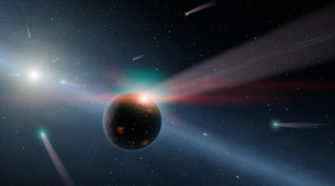Topic
Special Topic: Exocomets
It is now generally accepted that the planets in our solar system formed via the accumulation of smaller bodies dubbed “planetesimals” – which in turn formed from the accumulation of dust grains and (in the outer and thus colder regions) gas molecules – early in its history. Due to the early sun’s rotation the infalling …
Special Topic: Asteroid (433) Eros
Two weeks ago I devoted the “Special Topics” presentation to the subject of near-Earth asteroids. Up until almost the end of the 19th Century all of the over 400 asteroids that had been discovered up to that time orbited within the “main asteroid belt” between Mars and Jupiter, and the astronomers of that era were …
Special Topic: The Oort Cloud
When examined from the standpoint of orbital characteristics, comets appear to come in one of two broad categories: short-period and long-period. Short-period comets, as this term implies, have relatively short orbital periods and often have been observed at numerous returns, while long-period comets, obviously, have long orbital periods and usually have only been observed once. …
Special Topic: Near-Earth asteroids
Last week’s topic concerned the asteroids that occupy the so-called “main asteroid belt” between the orbits of Mars and Jupiter. The overwhelming majority of the first several hundred asteroids discovered, and, indeed, a large majority of the asteroids known today, reside in this region. However, as years went by and more and more asteroids kept …
Special Topic: Main belt asteroids
Ice and Stone 2020 is a weekly series of educational material focusing on some of the small bodies of the solar system – comets and asteroids. The Earthrise Institute, a non-profit founded by Comet Hale-Bopp co-discoverer Alan Hale, is partnering with the La Cumbres Observatory and RocketSTEM to release the material for FREE online so that …





